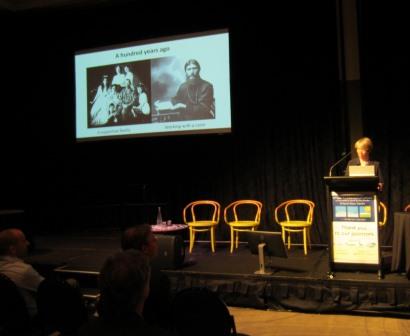GAVIN FINKELSTEIN
Gavin Finkelstein is President, Haemophilia Foundation Australia
We had an excellent Conference on the Gold Coast. As we were competing with public and school holidays, the AFL Grand Final and other events, as well as the potential for a post 2014 World Congress anticlimax, we felt our numbers held up well. The program session topics were vibrant and inclusive of all interests, relevant and current. I sincerely thank the multidisciplinary program committee members and HFA staff who worked hard to make the Conference a success. For those who were unable to attend, we are pleased to be able to provide summaries and key learning points from some of the Conference sessions in this edition of National Haemophilia. Many of the presentations will also be posted on the HFA website in upcoming weeks.
The vibe at the hotel lent itself to a good conference. It was great to catch up with everyone and it had a real fun and relaxed feel without even leaving the hotel. It was a bit of fresh air, engaging and enjoyable. Congratulations to everyone involved. A conference like this helps to reinvigorate everyone attending and revitalise their interest.

Conference delegates catching up over lunch
It was also important to see that women’s issues have come to the forefront. It was a great opportunity to discuss the real issues for women and see bleeding issues in the context of their lives.
The conference was followed by our annual Council meeting and Annual General Meeting -our first since the constitution changes in 2014. These changes had been aimed at encouraging stronger local member organisation participation. I think we achieved that for the first meeting, and we are off to a good start. It was great to have most State/Territory Foundation Presidents, former Delegates and other local representatives around the table. This lead to robust discussion and I think it augurs well for a strong and purposeful future for HFA. I welcome David Fagan as HFA’s new Treasurer. He follows Ann Roberts who has served HFA in various office bearer roles over the years. Ann’s dedicated service to HFA was recognised at the Conference Dinner when Life Governorship was presented to her. I am pleased to continue for another term as HFA President, with Dan Credazzi as our Vice President.
A common concern of Council members following the Conference was how people with bleeding disorders can proactively work with their treating health professionals to improve their care and treatment and strengthen government engagement at all levels to support best practice. An important outcome of these discussions was that local foundations will work with HFA to encourage our membership to use MyABDR, and to make sure people record their clotting factor use so that it becomes a regular part of clinic reviews and individual care plans. Monitoring our bleeds is critical to understanding how treatment will work best for us, and how we can get the best out of our treatments, and improve our quality of life. In turn, it makes sense that a clearer understanding of our bleeding patterns helps us to dose at the appropriate times. Most importantly, we need to record our clotting factor use and bleeds, where we have them, so this can be understood and so we get the best treatment advice.
Right from the first Conference session when Prof Alison Street presented on the history and development of haemophilia care we could relate to the progress that has been made with comprehensive care – life without treatment and how things have changed. The importance of comprehensive care was echoed throughout the Conference, yet in a country like ours, where huge amounts of taxpayers’ funds are spent on clotting factor, there is a disproportional under-commitment to comprehensive care.

Alison Street presenting on comprehensive care
Patient responsibility for engaging with comprehensive care and MyABDR were prominent in some conference sessions. With free clotting factor treatment and comprehensive care, the patient also has a responsibility to contribute to their own care. It’s their part in helping the treating team to manage their condition in the best way possible by providing the information that the team needs. Recording with MyABDR is an important part of the clinical process. You may not realise you are getting a target joint unless you are recording bleeds and your product treatment usage, and if you do record, the clinical team will be able to review this with you and develop a management plan. There is a gap if this isn’t recorded. But getting involved in your own care is to your own benefit and will only help with your treatment regimen.
Please speak to your treatment centre staff if you are not yet using MyABDR, as this is a critical part of managing our overall care and treatment. The Council is committed to this tool, as we see it is a very important way of ensuring governments understand our treatment needs, and make appropriate budget provision for supply plans. During the Conference you will have become aware of the gaps in services at some Haemophilia Centres. If only we could see some of the savings made on clotting factor tenders being redirected into comprehensive care, especially where services do not exist or are inadequate. Our federation and health funding models makes it difficult, but we must surely impact positively on health outcomes, and budgets if all parts of the jigsaw are put together. This investment in the future is important and will ultimately reduce healthcare costs. We eagerly await the publication of the new treatment guidelines for Australia, and hope this will have a positive impact on men and women with bleeding disorders in Australia, and lead to a body of evidence that supports this.
At the time of writing HFA is anxiously awaiting the outcome of a major grant application to the federal government for funding for our national secretariat. Without this grant HFA would not be able to represent the bleeding disorders community as we do, and we remain optimistic that our past performance as a national peak body will be recognised and funded
The conference gave our youth a chance to meet up again, following their meetings at the 2014 Congress and some of the training opportunities they have had. I really enjoy the engagement with youth. The Conference brings them together every couple of years; they get to know each other, they discuss their issues, they build themselves a network. This has far reaching implications both for them and for the future for our haemophilia foundations..
It is exciting to see advances in treatment. Longer acting factors will make a huge difference for some people. Many are already seeing the impact of less infusions through their participation in clinical trials. But I do not believe longer acting factors are the be all and end all of everything for all people with haemophilia. For young families and younger people this could be life-changing; older people who are used to their treatment regimens might be more focused on different aspects of treatment. However, they should be available as a part of a suite of products. Nevertheless, we still see an oral pill or gene therapy as part of the holy grail. And of course what is critical is that we have products which do not increase the risk of inhibitors.
Our priorities are all about having a healthy population that live a full and normal life and contribute to society. It’s looking good for the future in terms of clotting factor treatments.
But I remained concerned about the delays for most people with bleeding disorders to access new hepatitis C treatments. Every day now the Foundation is hearing about the new hepatitis C treatments which are having remarkable outcomes with so few side-effects. They are not yet available in Australia except through clinical trial or very limited compassionate access. People in our community who have been able to access these treatments are seeing their lives turn around. However, at the Conference I heard of so many community members who are falling through the cracks of clinical trials and compassionate access – and that more community members are finding that they have cirrhosis. If you develop cirrhosis, even if you have successful treatment, you will need to be monitored for liver cancer for the rest of your life.
We are excited by the new treatments and people are more prepared to take on treatment. They are also getting older, which is a risk factor for disease progression; they need to be treated now. I am sure it is better for the government to invest in treating people with bleeding disorders now and to save money on more complex care in the future.
There are some key messages for community members about hepatitis C.
If you have hepatitis C, you need to be proactive, show that you will be prepared to do whatever is required to undergo treatment, and show that you will take care of yourself in the interim. Don’t give up at this point; holistic care is really important. Go to clinics, get your liver health checked, manage your lifestyle, make sure you get in the system, and that way you are best placed for treatment when it becomes available.
Haemophilia Foundation Australia acknowledges the Traditional Owners and Custodians of Country throughout Australia, the land, waters and community where we walk, live, meet and work. We pay our respects to Elders past and present and extend that respect to all Aboriginal and Torres Strait Islander peoples.
Sign up for the latest news, events and our free National Haemophilia magazine